First let me start up front by stating that I am not an expert. I read A LOT and I try to learn a lot. I understand most of what I read, but admittedly not all. I try to test what I read with my own practical application as much as I can.
Now that I have the disclaimers out of the way, I wanted to start a thread to discuss some of what is actually going on with some of the antennas that have seen interest in this forum and others. Specifically, the 1/4 wave ground plane like the Starduster and Merlin as well as comparison to other verticals like the 5/8 wave Imax. I have seen a lot of nonsense posted around the internet (especially about the Merlin) but little factual discussion about what is going on and why.
First let's start with this statement from another forum:
Wrong.
This type of antenna has been tested and modeled extensively. The effects of loading coils and their placement along the vertical element of the antenna has been tested and modeled extensively. The use of capacitance hats has been tested and modeled extensively as has the combination of loading coils with cap hats. A statement like the above shows that the author has not even attempted to research what testing has been done because the information isn't that difficult to find.
Lets start with the comparison between any 1/4 wave vertical groundplane and a 5/8 wave vertical like an Imax. Actually we could be using any end fed 5/8 wave that has insufficient ground plane. Here is an excerpt from a very good article by W8JI on the subject (links with complete text at the end of this post). Some of the emphasis is my own:
Begin quote--------------------------------
The J-pole is a worse-case situation for examining unwanted feedline radiation. In the case of the J-pole without radials, all of the common mode current created by the poor feed system flows over the coax shield and mast. The mast and coax is generally vertical and as high and clear as the actual thing we think is the antenna, and so unwanted radiation from the feedline is much more apparent than in the low-band Zepp where both feedline and antenna are near earth.
We will use this as a reference.
Here is the pattern of a 1/4 wl groundplane antenna without proper feedline decoupling:
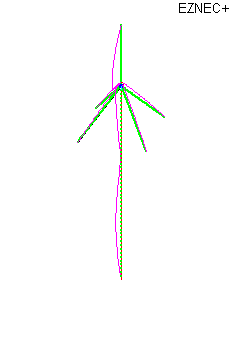
In the above model common mode current obviously exists on the feedline. The amount of current is actually significant, almost 1 ampere compared to 2.5 amperes in the antenna (500 watts applied)! A 1/4 wave groundplane with four radials actually needs a balun or some other form of feedline decoupling.
The pattern in freespace of this antenna is:
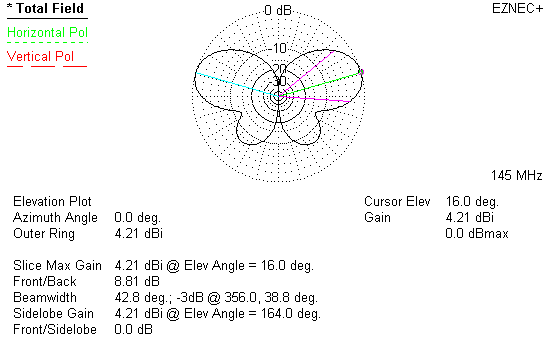
The pattern distortion is caused by feedline common-mode current. If you think this is bad, imagine what happens with an end-fed antenna (even a 1/2 wave antenna) and NO radials! In that case all of the antenna current flows over the feedline shield! Many antenna designs actually use the feedline and mast radiation that others dismiss as "insignificant" to increase antenna gain. In some cases, the antenna designers really don't even understand what they did to create a "Magic antenna".
Here is the same 1/4 wl groundplane with a feedpoint balun with a common-mode impedance of 3000 j3000:
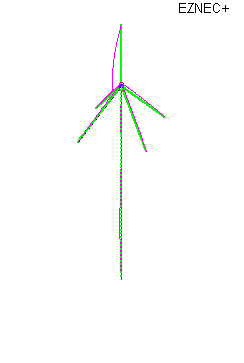
In this case feedline currents are under .4 amperes, and antenna current increases to 3 amperes. pattern is:
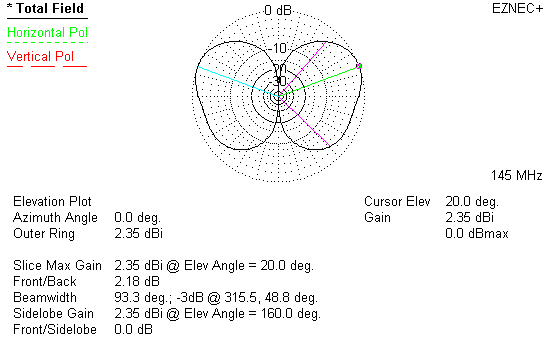
See how much cleaner the pattern is? The pattern is much cleaner and more like what we expect from a groundplane far above earth. We still don't have a good system, because the balun needs a ground on the "unbalanced" side to be effective. (This is why I recommend grounding the unbalanced side of baluns to antenna booms of Yagi antennas. That coil of wire hanging in the air might not be enough without a ground!)
With a perfect balun and optimum de-coupling (a few extra radials below the balun or an extra-ordinary balun), the pattern looks like this:
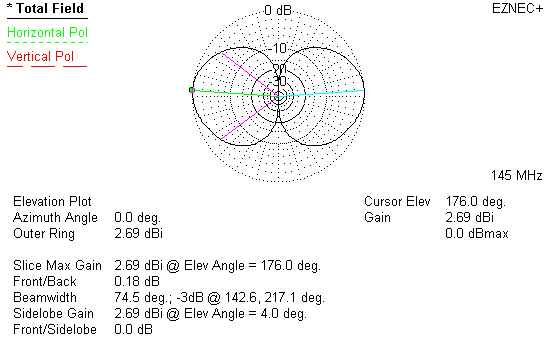
This is the ideal pattern of a 1/4 wl groundplane, and it takes extraordinary care to obtain this pattern. Many people think they have this pattern, because they model antennas without the feedline attached!
To obtain this pattern I had to:
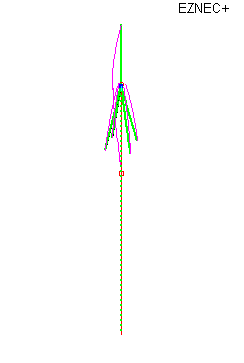
It is easily possible to do this in the real world. Instead, we have numerous articles that ignore the feedline and assume we don't have a problem with common mode current upsetting antenna pattern.
Worse yet, some articles claim the groundplane antenna only needs one or two radials!! Why does this happen? Because the person who made that assumption never modeled the mast or feedline. They eliminated the real-world problem through an omission in the model.
If an antenna model does not include the feedline, losses in the feedline, or imperfections in the source it much more likely than not is a flawed model. The real-world antenna often will be much different if the model ignores feedline loss and feed system source or matching system problems. Short dipoles are one example.
(...)
The following model is an I-Max 2000 vertical with a vertical feedline. In this case I picked the worse feedline length:
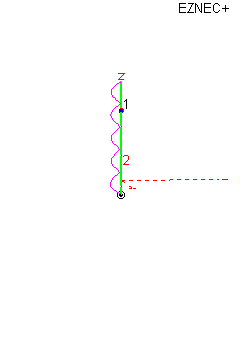
Feedline current is 100% of antenna current. This illustrates why so many people complain about SWR problems and RF in the shack with end-fed verticals like the I-MAX 2000!
Here is the pattern of an antenna that copies the I-MAX dimensions and feed system:
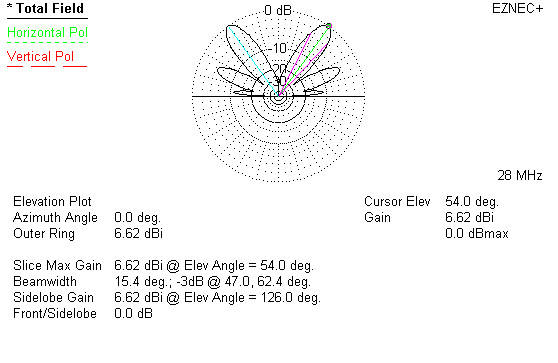
This is a NEGATIVE gain antenna at low angles. A 1/4wl groundplane would seriously out-talk the I-MAX 2000 or any other 5/8th wl antenna that does not have a large groundplane.
Even if we use the optimum feedline and mast length, here is the very best the end-fed antenna will do:
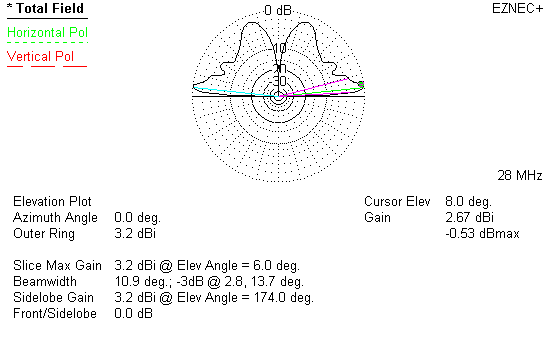
In this case we now have 2.67 dBi, which is actually a little less than a 1/4wl groundplane will do! The severe common-mode mast and feedline currents make "no-radial" verticals extremely sensitive to mounting height, mounting structure, feedline length, and grounding. This is NOT normal for antennas, it is a sign of a design problem.
(...)
ANY END-FED ANTENNA REQUIRES A LARGE GROUNDPLANE OR OTHER EXTRAORDINARY ISOLATION METHOD OR METHODS TO PREVENT FEEDLINE OR MAST COMMON MODE CURRENTS!
This is true for 5/8th waves, Zepp antennas, R7's, R5's, or even common J-poles. End-feeding antennas is bad news unless you have a large well-established ground at the feedpoint. Even 1/4wl groundplanes have common mode problems.
Some manufacturers have wised-up.
Cushcraft, in their Ringo-Ranger, eventually added a separate additional groundplane below the antenna to tame the wild common-mode currents of the Ringo. Even that solution is barely acceptable.
The Isopole antenna used multiple sleeve sections to decouple the feedline, and it probably was one of the best antennas available for immunity to feedline coupling problems.
This problem gets worse when the element is 5/8th wave long. Think of that when you read claims of "no-radial" CB antennas with "3dB gain" and a low wave angle. They actually have negative gain at desired DX angles over a conventional 1/4-wave groundplane! Instead concentrating your signal towards the neighbor's TV set or an airplane flying overhead. They cause your entire antenna system to be critical for feedline grounding, routing and length and even allow moisture on the feedline jacket to change performance of the system!
end quote--------------------------------------------
BTW, antennas like the Interceptor 10K (and others) do have a proper ground plane system. Models of well designed 5/8 wl antennas with proper radials will be different than those shown above.
On to the Merlin 1/4 wave vertical: This antenna has a large load coil right at the top of the antenna followed by a very large cap hat directly above the coil. W8JI also has a very in-depth article about what load coils do, how they work, and what they don't do. One important thing to understand is that adding a coil does not "make up" for the missing fraction of a wavelength in the antenna. Here's another quote from W8JI:
--------------------------------
The coil simply inserts a series inductive reactance that cancels capacitive antenna reactance. When a 150 ohm reactance inductor is inserted in series with a 150 ohm capacitive load (like an antenna), only the resistive parts remain.
--------------------------------
In this article, he explains how he built and used a current meter to test out various coils, coil placement, and combinations with cap hats. He is primarily testing on 1/4 wave mobile antennas, but since we are discussing a 1/4 wave antenna, the principles are the same. One of the learnings from the tests was, "Clearly we do NOT want...a large hat just above a large coil". Later in the same article, "When installing a loading coil of substantial inductance in an electrically short antenna, sheetmetal and dielectrics should be kept away from the coil and areas of antenna above the loading coil. This would include dielectrics on or near the inductor, since the presence of dielectrics would increase undesirable capacitance." Yet this is exactly what the Merlin does. The load coil terminates directly into a metal shaft from which the cap hat is attached directly above the coil.
With a shortened 1/4 wave vertical adding a coil in the middle causes the amount of current to pretty much stay constant from base through the coil and then it starts to taper off. This is a good thing because it moves the amount of current up higher in the antenan. However, there is a price to pay (no such thing as a free lunch) because there is always loss in the inductor. This inductor loss means that some power is lost as heat dissipation. One way to solve this problem is to introduce a cap hat at the end of the antenna. This helps move more of the current up the antenna and reduce the power lost in the inductor. However, placing the large cap hat directly above the coil (and worse, connecting the two with solid metal) causes high stray capacitance, which can cause a significant taper in current between the bottom of the coil and top of the coil. This is a problem. All of that aside, what we really need to understand is that the coil in the Merlin antenna very unnecessary if the proper length vertical element is use, as is the case with the Starduster. In fact, it's more detrimental than anything.
If you combine the first information about feedline current in a 1/4 wave groudplane with an understanding of what a cap hat and coil accomplish, it starts to become apparent what the designer of this antenna *thinks* he accomplished. Because of the existance of the feedline current on an improperly installed 1/4 groundplane, the feedline is acting as part of the antenna. By top loading the antenna with the coil and the cap hat (the hat is doing most of the work on that antenna) some of the current that exists below the radials on the feedline is getting moved farther up the antenna! Don't forget, there is a price to pay for doing it this way. In addition to the losses already discussed, you're also shortening the antenna. Remeber the old saying: "Five hundred feet of wire in a one foot long tube is still one foot of antenna". Of course, the simple way to eliminate or greatly reduce the feedline current has already been discussed.
Of course we haven't even touched on the different radiation patterns between the 1/4 wave vertical and (well designed) 5/8 wave verticals. That should be part of the discussion when comparing these antennas, as well.
I'm sure this will spur an interesting discussion. I'm sure I probably made some mistakes in my analysis, so I look forward to the discussion.
In the meantime, here are the two referenced (long) articles for you reading pleasure
Mobile antennas, short verticals, loading coil loss,and loading coil current
End-fed vertical j-pole and horizontal zepp I-max 2000 vertical
Now that I have the disclaimers out of the way, I wanted to start a thread to discuss some of what is actually going on with some of the antennas that have seen interest in this forum and others. Specifically, the 1/4 wave ground plane like the Starduster and Merlin as well as comparison to other verticals like the 5/8 wave Imax. I have seen a lot of nonsense posted around the internet (especially about the Merlin) but little factual discussion about what is going on and why.
First let's start with this statement from another forum:
At the same time, the Merlin is a VERY unique antenna. I would reckon that a design such as this never was tested in the labs back when the other omni's were tested. Therefor it makes it hard to really fight for or against the antenna unless you have personal experience with it and can honestly say it works better than another said antenna without bending the truth at all.
Wrong.
This type of antenna has been tested and modeled extensively. The effects of loading coils and their placement along the vertical element of the antenna has been tested and modeled extensively. The use of capacitance hats has been tested and modeled extensively as has the combination of loading coils with cap hats. A statement like the above shows that the author has not even attempted to research what testing has been done because the information isn't that difficult to find.
Lets start with the comparison between any 1/4 wave vertical groundplane and a 5/8 wave vertical like an Imax. Actually we could be using any end fed 5/8 wave that has insufficient ground plane. Here is an excerpt from a very good article by W8JI on the subject (links with complete text at the end of this post). Some of the emphasis is my own:
Begin quote--------------------------------
The J-pole is a worse-case situation for examining unwanted feedline radiation. In the case of the J-pole without radials, all of the common mode current created by the poor feed system flows over the coax shield and mast. The mast and coax is generally vertical and as high and clear as the actual thing we think is the antenna, and so unwanted radiation from the feedline is much more apparent than in the low-band Zepp where both feedline and antenna are near earth.
We will use this as a reference.
Here is the pattern of a 1/4 wl groundplane antenna without proper feedline decoupling:

In the above model common mode current obviously exists on the feedline. The amount of current is actually significant, almost 1 ampere compared to 2.5 amperes in the antenna (500 watts applied)! A 1/4 wave groundplane with four radials actually needs a balun or some other form of feedline decoupling.
The pattern in freespace of this antenna is:

The pattern distortion is caused by feedline common-mode current. If you think this is bad, imagine what happens with an end-fed antenna (even a 1/2 wave antenna) and NO radials! In that case all of the antenna current flows over the feedline shield! Many antenna designs actually use the feedline and mast radiation that others dismiss as "insignificant" to increase antenna gain. In some cases, the antenna designers really don't even understand what they did to create a "Magic antenna".
Here is the same 1/4 wl groundplane with a feedpoint balun with a common-mode impedance of 3000 j3000:

In this case feedline currents are under .4 amperes, and antenna current increases to 3 amperes. pattern is:

See how much cleaner the pattern is? The pattern is much cleaner and more like what we expect from a groundplane far above earth. We still don't have a good system, because the balun needs a ground on the "unbalanced" side to be effective. (This is why I recommend grounding the unbalanced side of baluns to antenna booms of Yagi antennas. That coil of wire hanging in the air might not be enough without a ground!)
With a perfect balun and optimum de-coupling (a few extra radials below the balun or an extra-ordinary balun), the pattern looks like this:

This is the ideal pattern of a 1/4 wl groundplane, and it takes extraordinary care to obtain this pattern. Many people think they have this pattern, because they model antennas without the feedline attached!
To obtain this pattern I had to:
- Use a good balun just below the radial tip level
- Ground the feedline shortly below the balun to a small groundplane
- Slope the radials downwards more, to a 75 degree angle.

It is easily possible to do this in the real world. Instead, we have numerous articles that ignore the feedline and assume we don't have a problem with common mode current upsetting antenna pattern.
Worse yet, some articles claim the groundplane antenna only needs one or two radials!! Why does this happen? Because the person who made that assumption never modeled the mast or feedline. They eliminated the real-world problem through an omission in the model.
If an antenna model does not include the feedline, losses in the feedline, or imperfections in the source it much more likely than not is a flawed model. The real-world antenna often will be much different if the model ignores feedline loss and feed system source or matching system problems. Short dipoles are one example.
(...)
The following model is an I-Max 2000 vertical with a vertical feedline. In this case I picked the worse feedline length:

Feedline current is 100% of antenna current. This illustrates why so many people complain about SWR problems and RF in the shack with end-fed verticals like the I-MAX 2000!
Here is the pattern of an antenna that copies the I-MAX dimensions and feed system:

This is a NEGATIVE gain antenna at low angles. A 1/4wl groundplane would seriously out-talk the I-MAX 2000 or any other 5/8th wl antenna that does not have a large groundplane.
Even if we use the optimum feedline and mast length, here is the very best the end-fed antenna will do:

In this case we now have 2.67 dBi, which is actually a little less than a 1/4wl groundplane will do! The severe common-mode mast and feedline currents make "no-radial" verticals extremely sensitive to mounting height, mounting structure, feedline length, and grounding. This is NOT normal for antennas, it is a sign of a design problem.
(...)
ANY END-FED ANTENNA REQUIRES A LARGE GROUNDPLANE OR OTHER EXTRAORDINARY ISOLATION METHOD OR METHODS TO PREVENT FEEDLINE OR MAST COMMON MODE CURRENTS!
This is true for 5/8th waves, Zepp antennas, R7's, R5's, or even common J-poles. End-feeding antennas is bad news unless you have a large well-established ground at the feedpoint. Even 1/4wl groundplanes have common mode problems.
Some manufacturers have wised-up.
Cushcraft, in their Ringo-Ranger, eventually added a separate additional groundplane below the antenna to tame the wild common-mode currents of the Ringo. Even that solution is barely acceptable.
The Isopole antenna used multiple sleeve sections to decouple the feedline, and it probably was one of the best antennas available for immunity to feedline coupling problems.
This problem gets worse when the element is 5/8th wave long. Think of that when you read claims of "no-radial" CB antennas with "3dB gain" and a low wave angle. They actually have negative gain at desired DX angles over a conventional 1/4-wave groundplane! Instead concentrating your signal towards the neighbor's TV set or an airplane flying overhead. They cause your entire antenna system to be critical for feedline grounding, routing and length and even allow moisture on the feedline jacket to change performance of the system!
end quote--------------------------------------------
BTW, antennas like the Interceptor 10K (and others) do have a proper ground plane system. Models of well designed 5/8 wl antennas with proper radials will be different than those shown above.
On to the Merlin 1/4 wave vertical: This antenna has a large load coil right at the top of the antenna followed by a very large cap hat directly above the coil. W8JI also has a very in-depth article about what load coils do, how they work, and what they don't do. One important thing to understand is that adding a coil does not "make up" for the missing fraction of a wavelength in the antenna. Here's another quote from W8JI:
--------------------------------
The coil simply inserts a series inductive reactance that cancels capacitive antenna reactance. When a 150 ohm reactance inductor is inserted in series with a 150 ohm capacitive load (like an antenna), only the resistive parts remain.
--------------------------------
In this article, he explains how he built and used a current meter to test out various coils, coil placement, and combinations with cap hats. He is primarily testing on 1/4 wave mobile antennas, but since we are discussing a 1/4 wave antenna, the principles are the same. One of the learnings from the tests was, "Clearly we do NOT want...a large hat just above a large coil". Later in the same article, "When installing a loading coil of substantial inductance in an electrically short antenna, sheetmetal and dielectrics should be kept away from the coil and areas of antenna above the loading coil. This would include dielectrics on or near the inductor, since the presence of dielectrics would increase undesirable capacitance." Yet this is exactly what the Merlin does. The load coil terminates directly into a metal shaft from which the cap hat is attached directly above the coil.
With a shortened 1/4 wave vertical adding a coil in the middle causes the amount of current to pretty much stay constant from base through the coil and then it starts to taper off. This is a good thing because it moves the amount of current up higher in the antenan. However, there is a price to pay (no such thing as a free lunch) because there is always loss in the inductor. This inductor loss means that some power is lost as heat dissipation. One way to solve this problem is to introduce a cap hat at the end of the antenna. This helps move more of the current up the antenna and reduce the power lost in the inductor. However, placing the large cap hat directly above the coil (and worse, connecting the two with solid metal) causes high stray capacitance, which can cause a significant taper in current between the bottom of the coil and top of the coil. This is a problem. All of that aside, what we really need to understand is that the coil in the Merlin antenna very unnecessary if the proper length vertical element is use, as is the case with the Starduster. In fact, it's more detrimental than anything.
If you combine the first information about feedline current in a 1/4 wave groudplane with an understanding of what a cap hat and coil accomplish, it starts to become apparent what the designer of this antenna *thinks* he accomplished. Because of the existance of the feedline current on an improperly installed 1/4 groundplane, the feedline is acting as part of the antenna. By top loading the antenna with the coil and the cap hat (the hat is doing most of the work on that antenna) some of the current that exists below the radials on the feedline is getting moved farther up the antenna! Don't forget, there is a price to pay for doing it this way. In addition to the losses already discussed, you're also shortening the antenna. Remeber the old saying: "Five hundred feet of wire in a one foot long tube is still one foot of antenna". Of course, the simple way to eliminate or greatly reduce the feedline current has already been discussed.
Of course we haven't even touched on the different radiation patterns between the 1/4 wave vertical and (well designed) 5/8 wave verticals. That should be part of the discussion when comparing these antennas, as well.
I'm sure this will spur an interesting discussion. I'm sure I probably made some mistakes in my analysis, so I look forward to the discussion.
In the meantime, here are the two referenced (long) articles for you reading pleasure
Mobile antennas, short verticals, loading coil loss,and loading coil current
End-fed vertical j-pole and horizontal zepp I-max 2000 vertical
